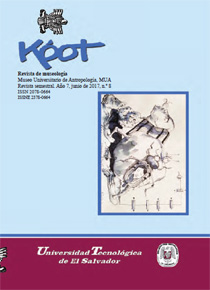Suchitoto, a heritage that is transformed: for whom? for what? And his heirs? towards a reflection on the human value of built heritage
DOI:
https://doi.org/10.5377/koot.v0i8.5874Keywords:
Cultural landscape, ethnographic record, memory, intergenerational transmission, trade, migration.Abstract
The city of Suchitoto, located in the department of Cuscatlán, is a place rich in history. It is embedded by a cultural heritage that was inherited from the early years of the republic, with an impressive historical legacy both in traditions and architecture which has survived until our present, allowing its current owners enjoy national and international tourists and visitors.
Such heritage projects identity and a sense of belonging to all its inhabitants. In fact, it is an essential component of the identity of the Salvadorans. However, what happens when due to situations of endogenous nature, those who have inherited and lived in the place have to leave and leave their roots? When is cultural heritage affected by trade and economic and social development factors? What about those who left their cultural heritage, tangible and intangible, in order to integrate other social niches outside their borders? How is this culture transformed?
This is a reality that Suchitoto is going through and millions of people are witnessing in cities in the world in both developed and underdeveloped countries. We must analyze and reflect this aspect from an anthropological stand point by finding a signifier and a meaning that serve as a path to promote better public policies that value the conservation and enhancement of the cultural heritage of the peoples since cultural heritage is identity, and therefore, an important cultural reference of its people.
Undoubtedly, valuable estates like Suchitoto are being transformed without the true human value with which was built by their ancestors. Moreover. Even its most recent inhabitants are emigrating to other cities of the world, as a sign of the trends of current consumption, leaving their cultural wealth in the hands of strangers who seek to alter it without taking into account the history, tradition and the human and architectural component that served as a base to set up this valuable cultural heritage.
We are aware that culture, heritage and identity are transformed as a normal process in any society, but it is not reasonable that a transformation is induced by new located players who are unaware of the rich historical and cultural values Suchitoto had in its memorable times.
Revista de Museología "Kóot" No.8 2017: 187-201
Downloads
717

